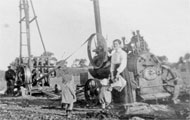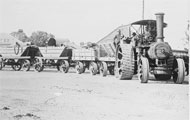- Agriculture
- Object :: Bush repaired Scoop
- Object :: Tumbling Tommy
- Interview :: Murray Smith
- Interview :: Peter Darley
- Windmills, pumps, steam power and engines
- Interview :: Max Jones
- Chaff Cutting
- Object :: Water Barrel
- Object :: Furphy Water Cart
- Ophir
- Object :: Gold Washing Cradle
- Object :: Picks and Mining Pan
- Object :: Chinese Scroll
- Object :: Chinese Shoulder Yoke
- Lucknow
- Historic Cadia
- Water at Cadia Valley Operations
- Interview :: John Ford
- Interview :: Joel Fossilo
- Object :: Testing Apparatus
Windmills, pumps, steam power and engines
Where there was no reticulated water supply, early farmers and graziers relied on windmills to lift water from bores, wells, creeks and dams to elevated tanks to supply water via pipelines to the house or to stock troughs around the property. Windmills were the cheapest way of raising water and were a crucial factor in the spread of population away from watercourses.

View Caption
Mechanical pumping in the 19th century was dominated by mass produced American equipment until the establishment of an Australian industry from the 1880s. Products ranged from hand operated well pumps to animal powered piston pumps and equipment such as pump jacks and centrifugal pumps requiring steam or internal combustion power. With the introduction of electricity many tedious water chores were replaced by the flick of a switch.

View Caption
Water is an important ingredient in steam power. The first steam engines were imported for use in flour mills, however usage increased during the gold rush periods providing power for mine dewatering and stamper batteries and mine winches. Steam engines also played a major role in Australia’s agricultural development in powering shearing plant, pumps, traction engines, chaff cutters, sawmills and other farm machinery.